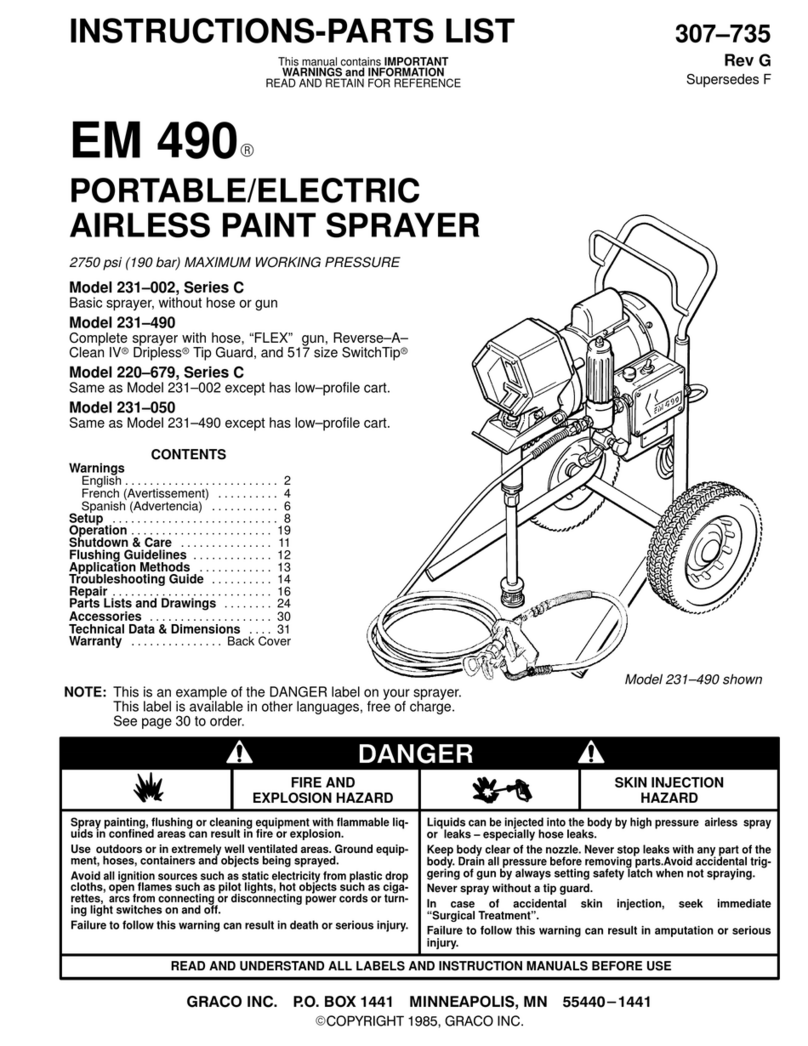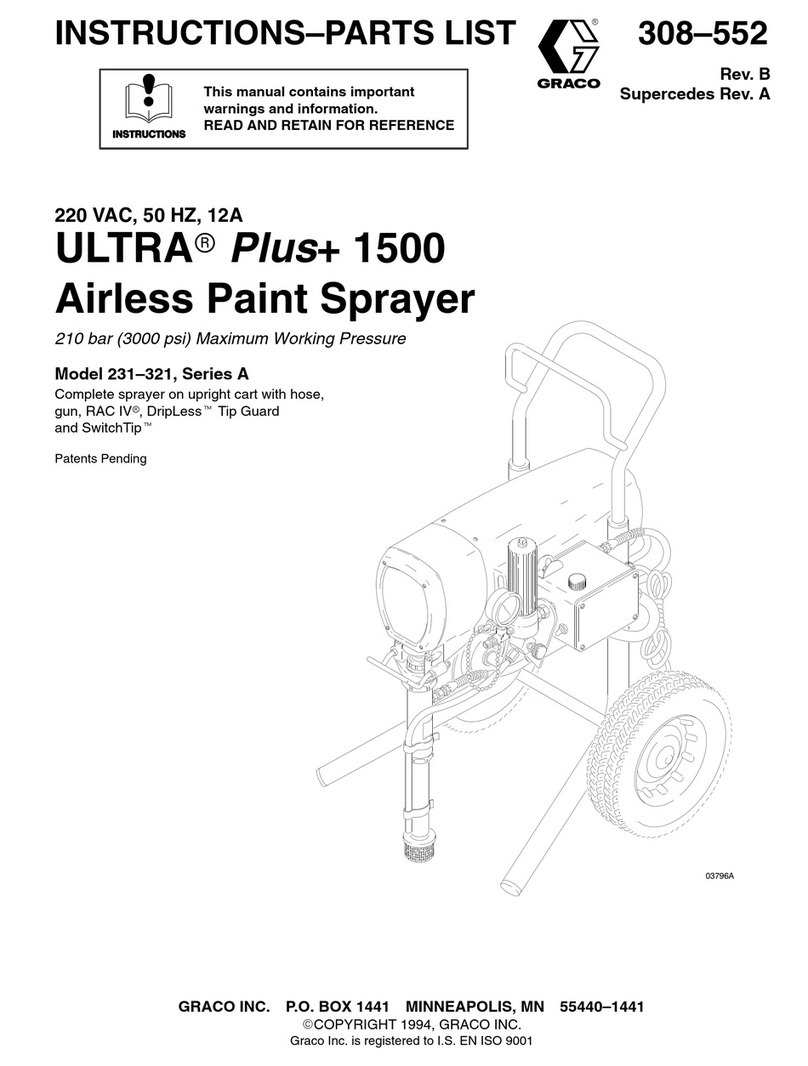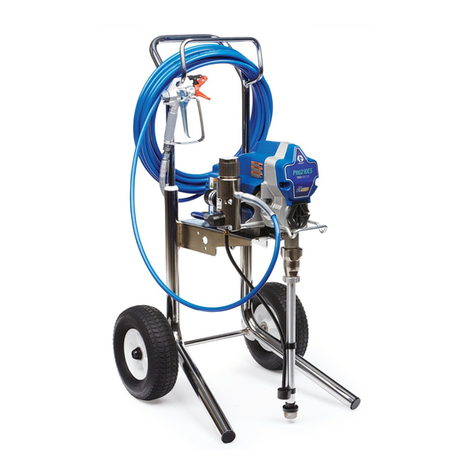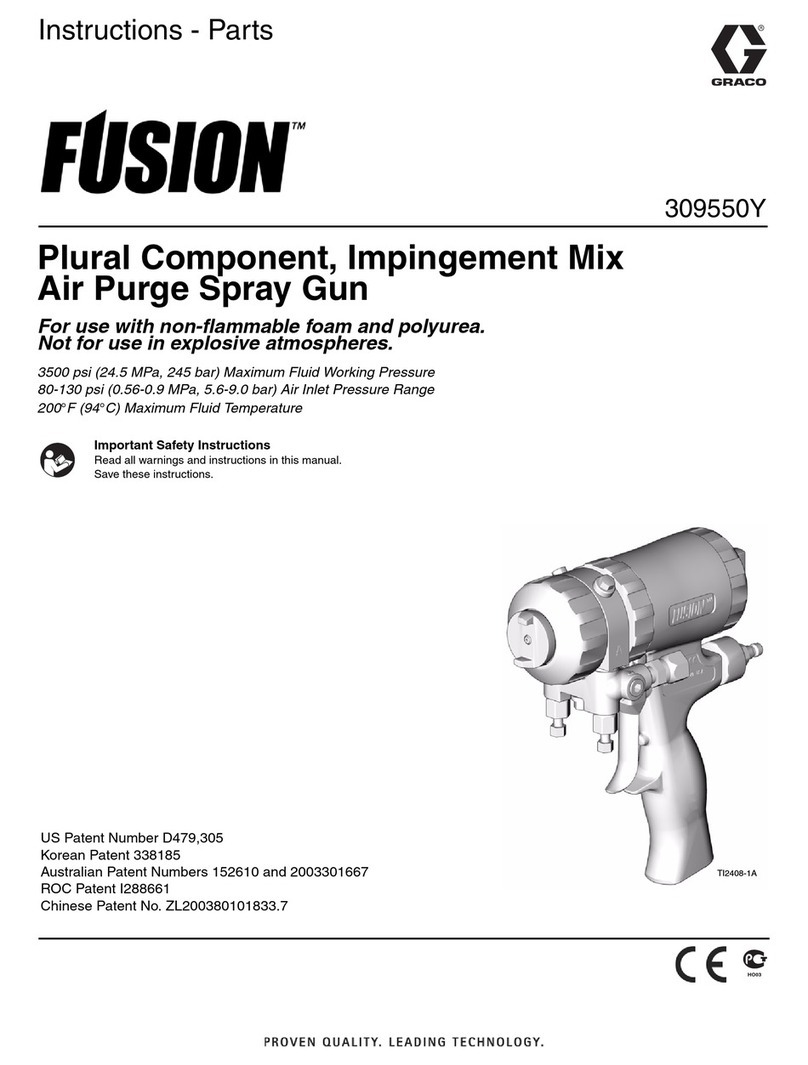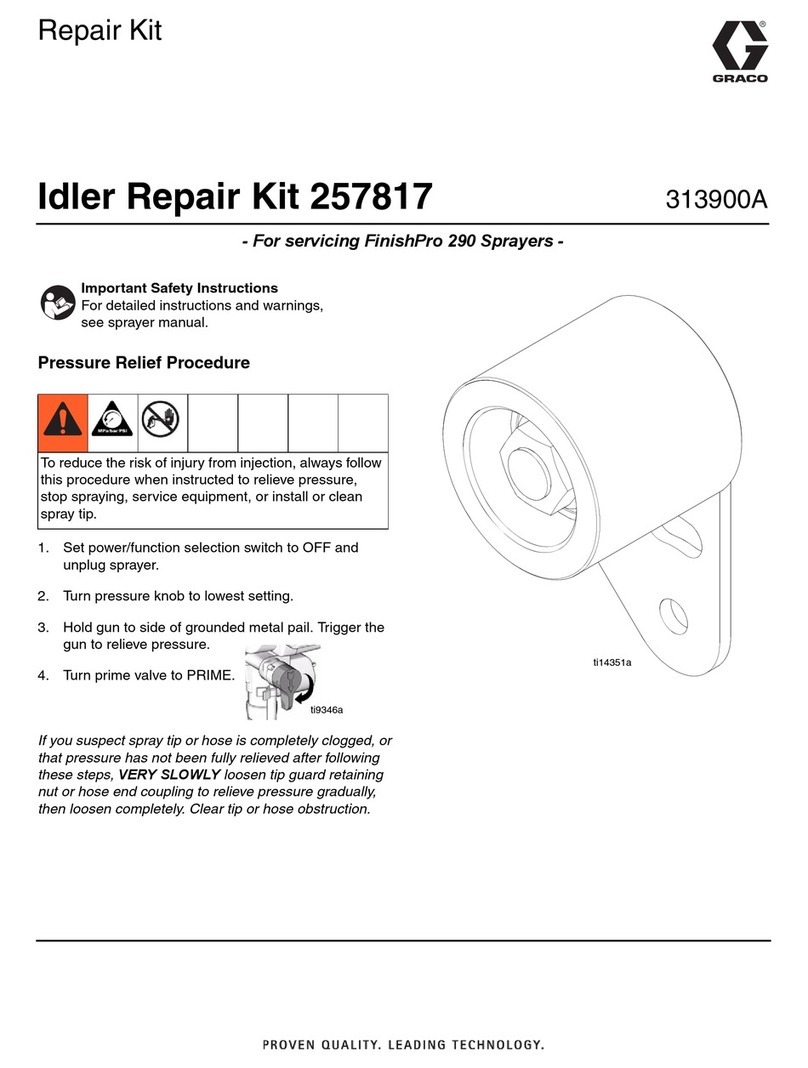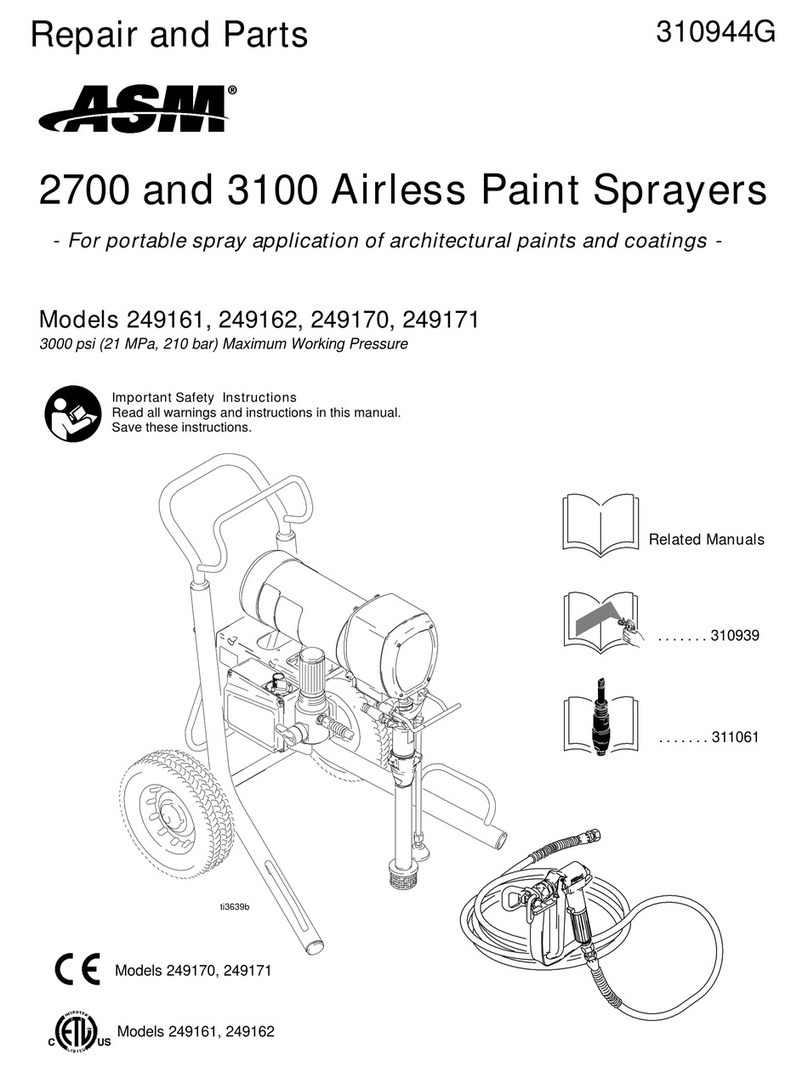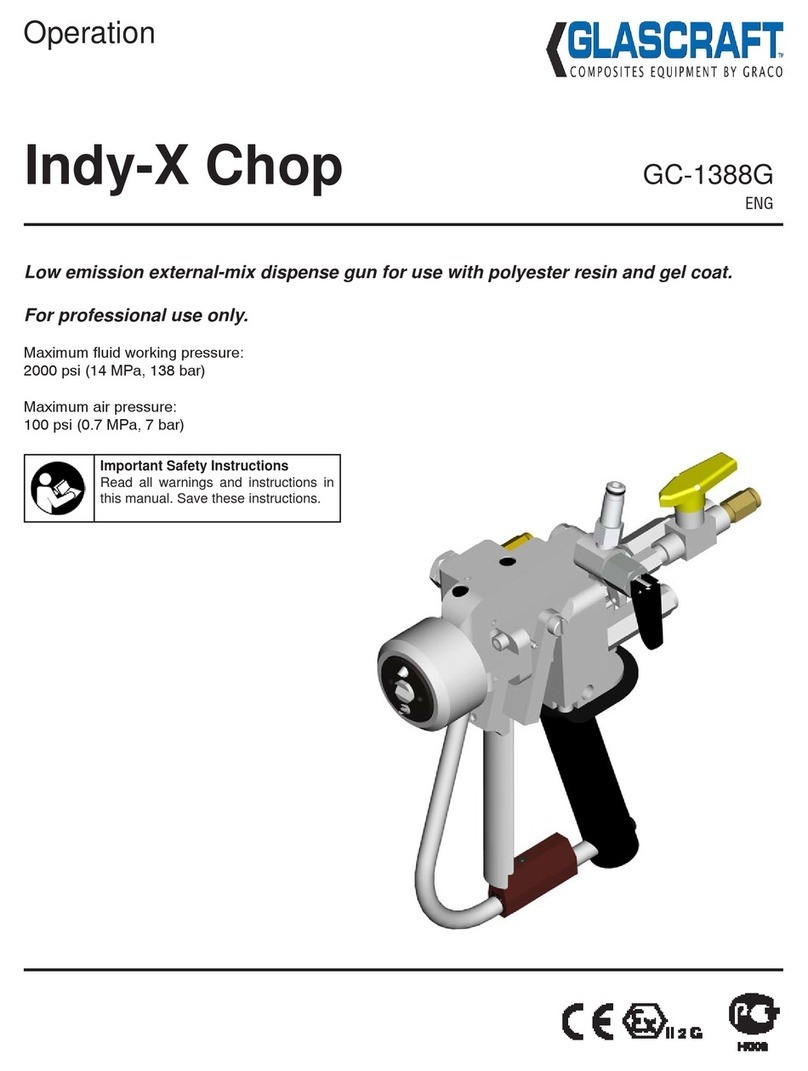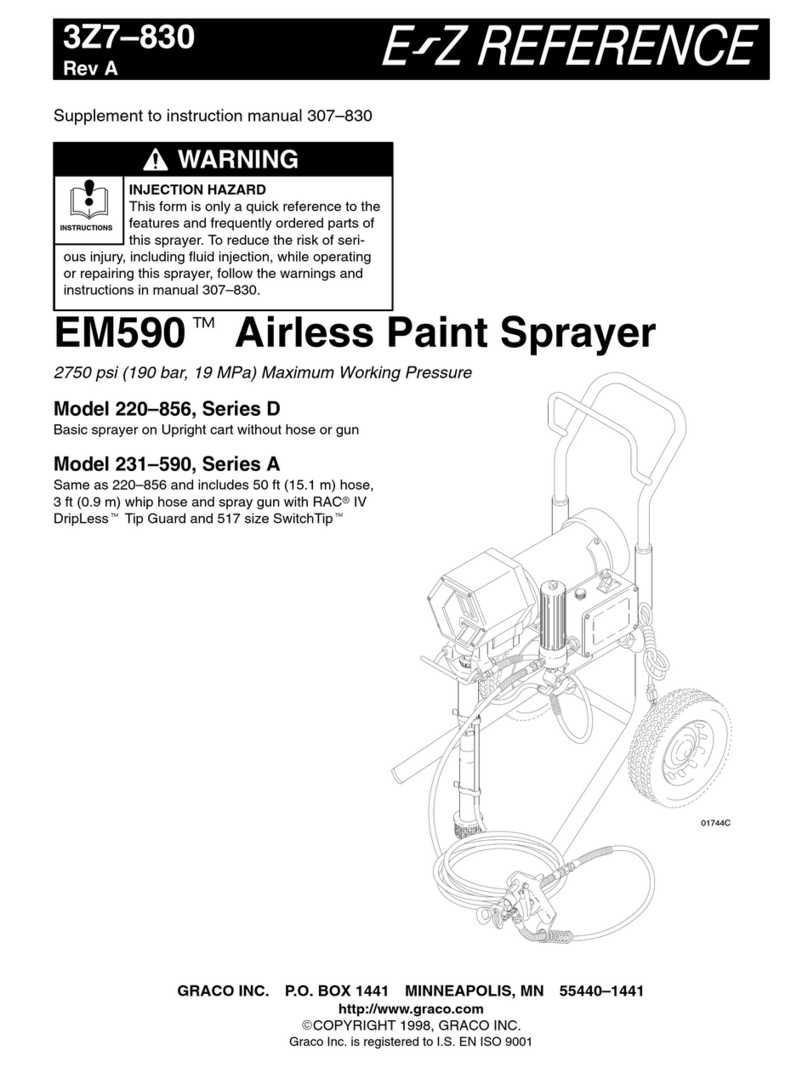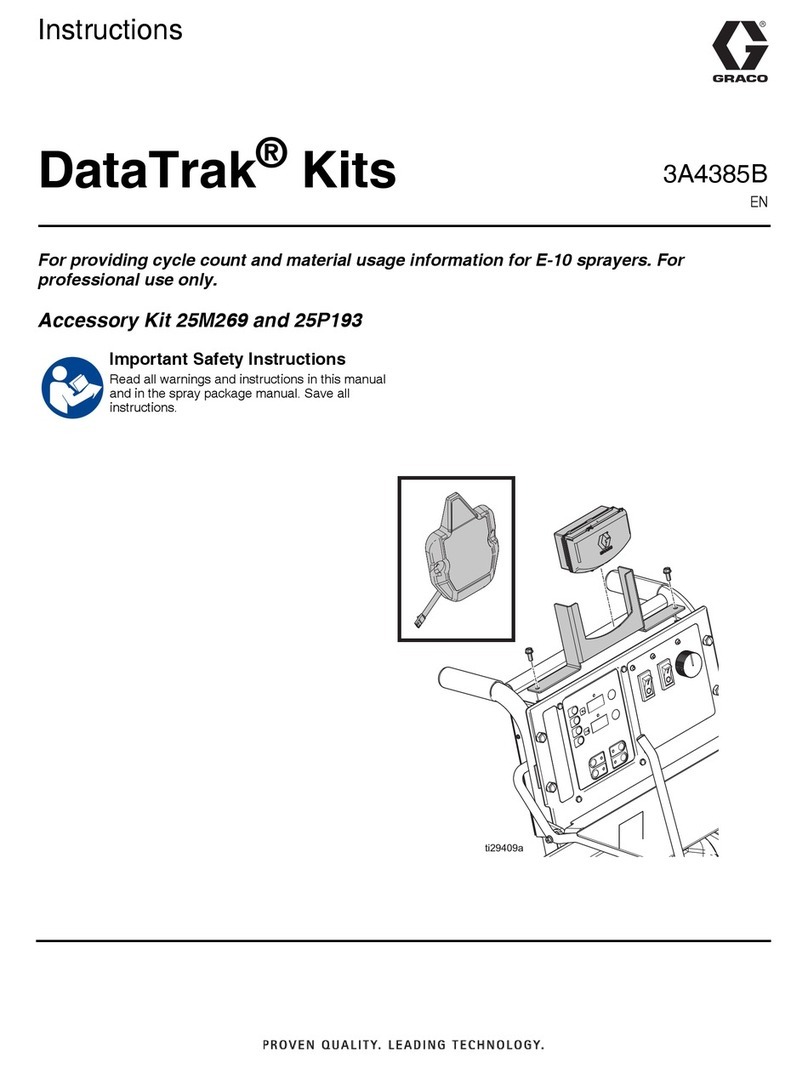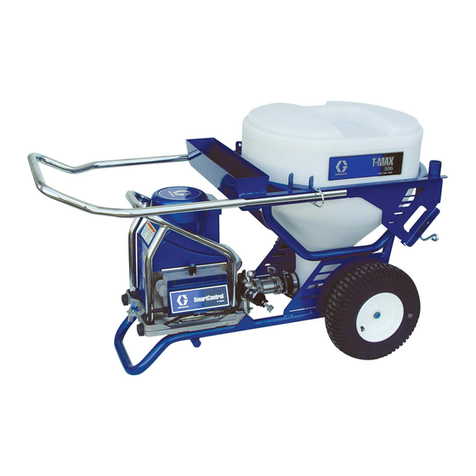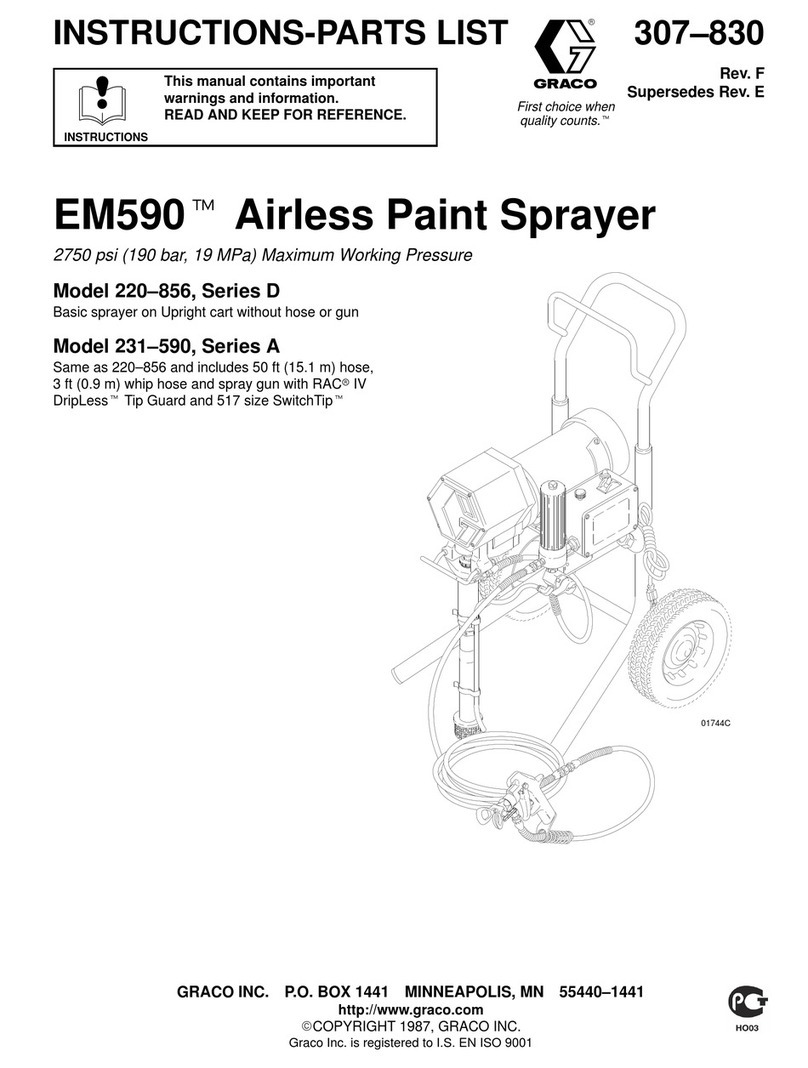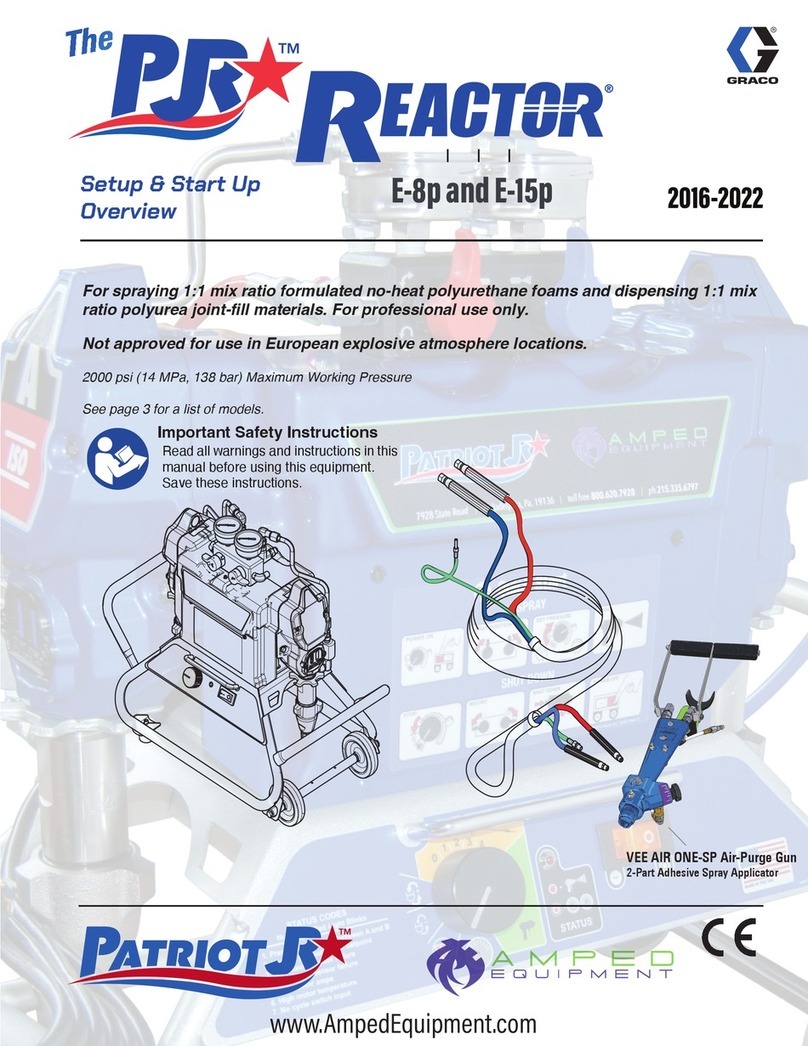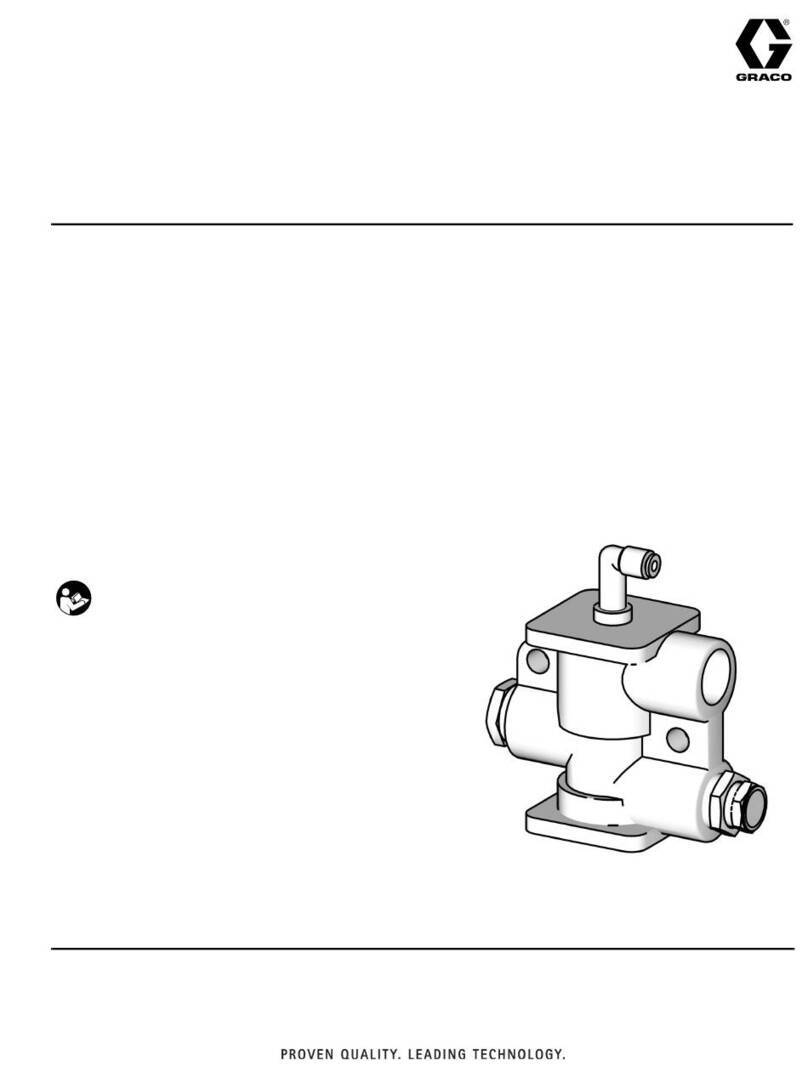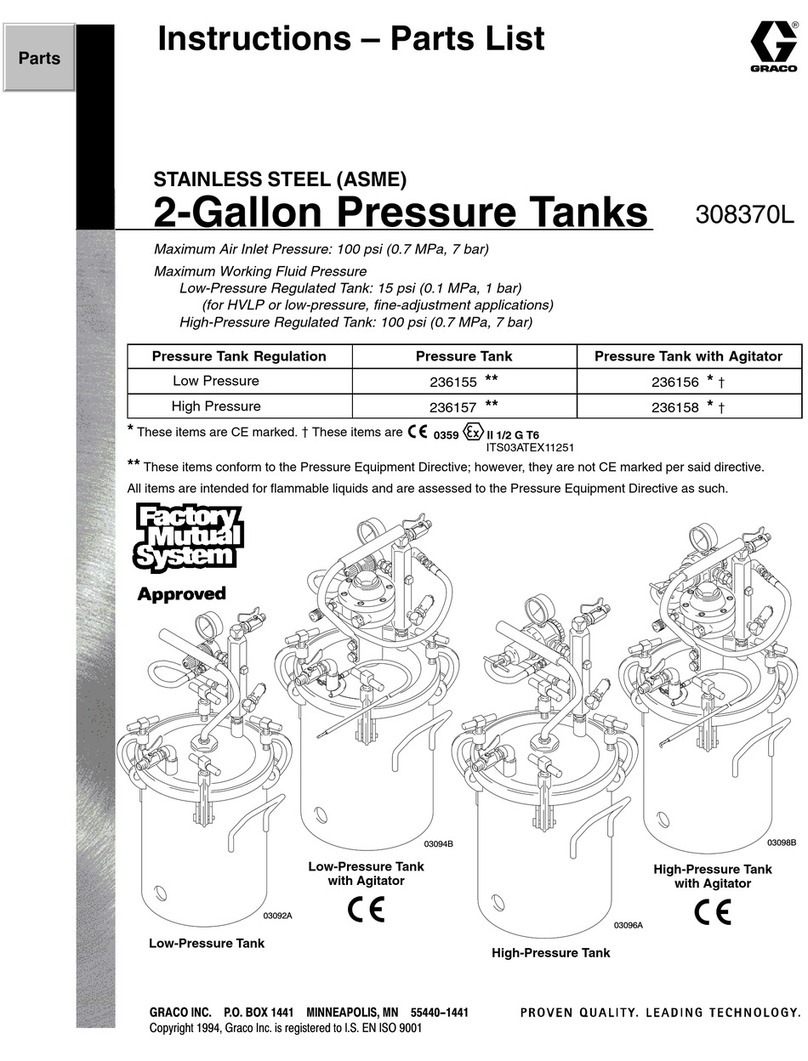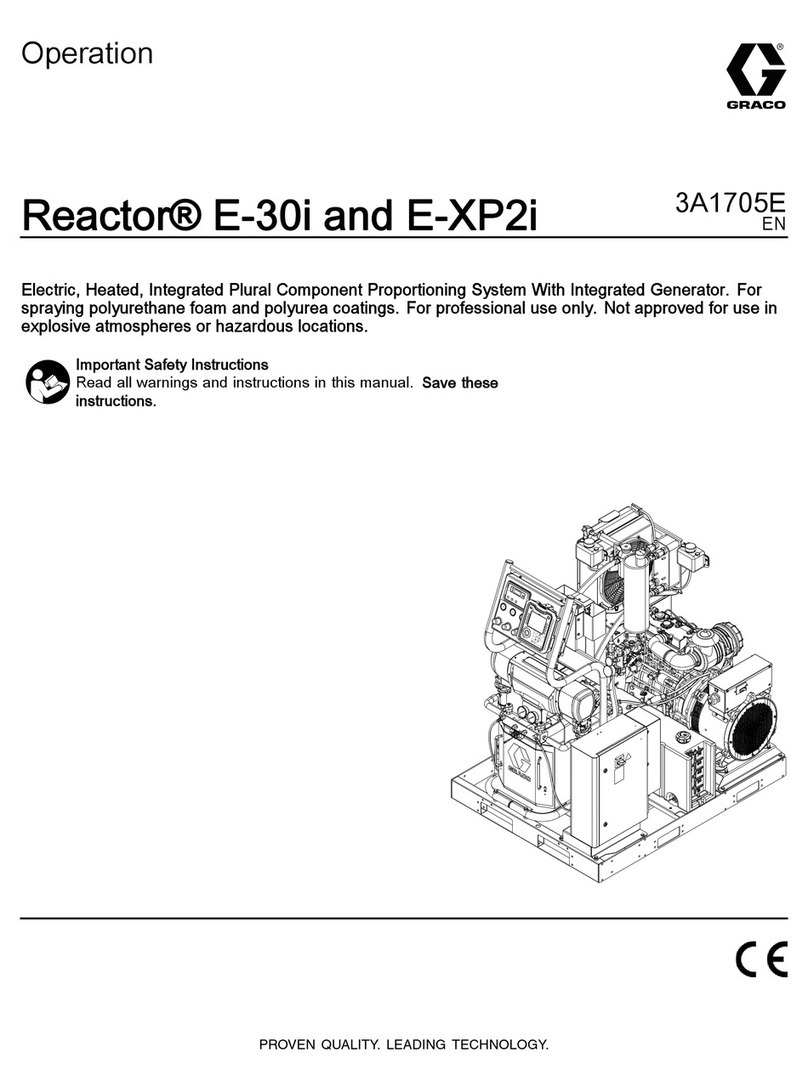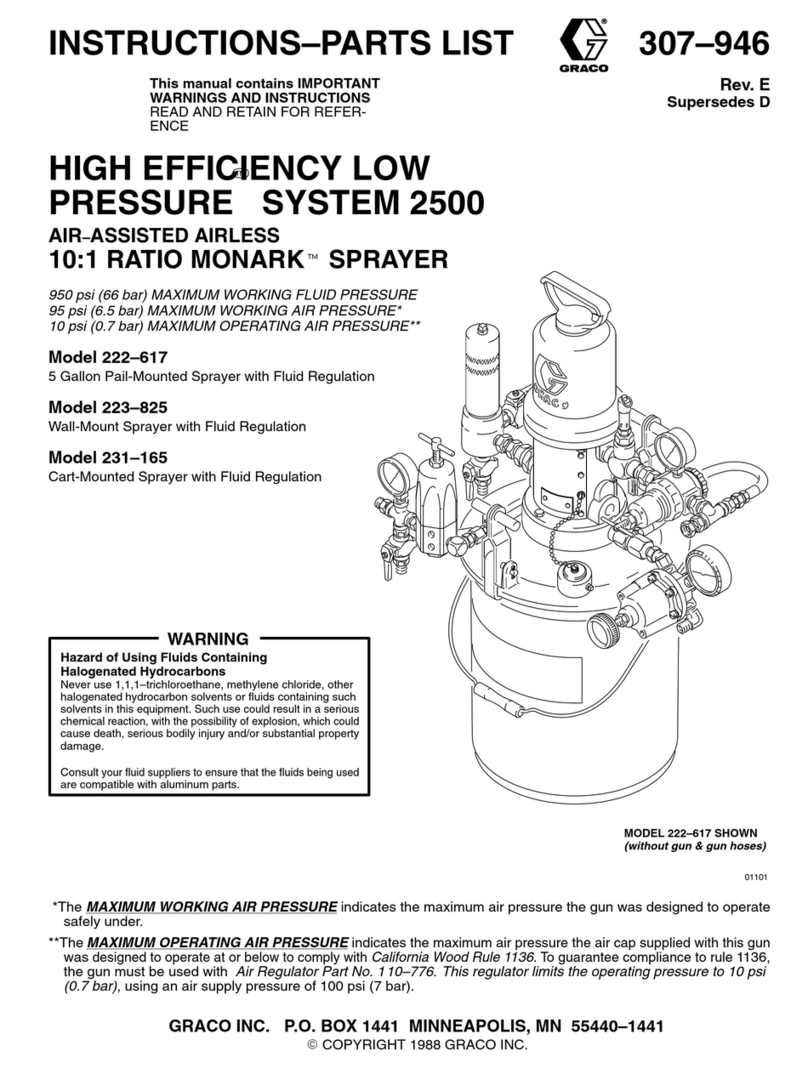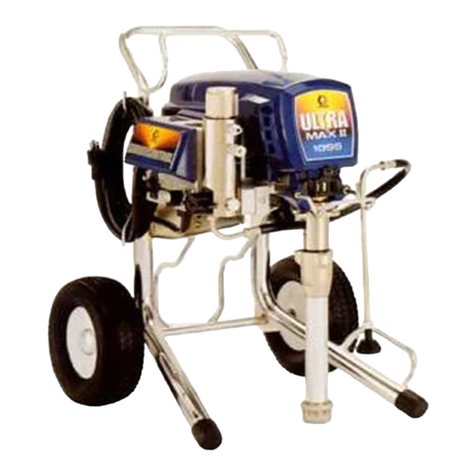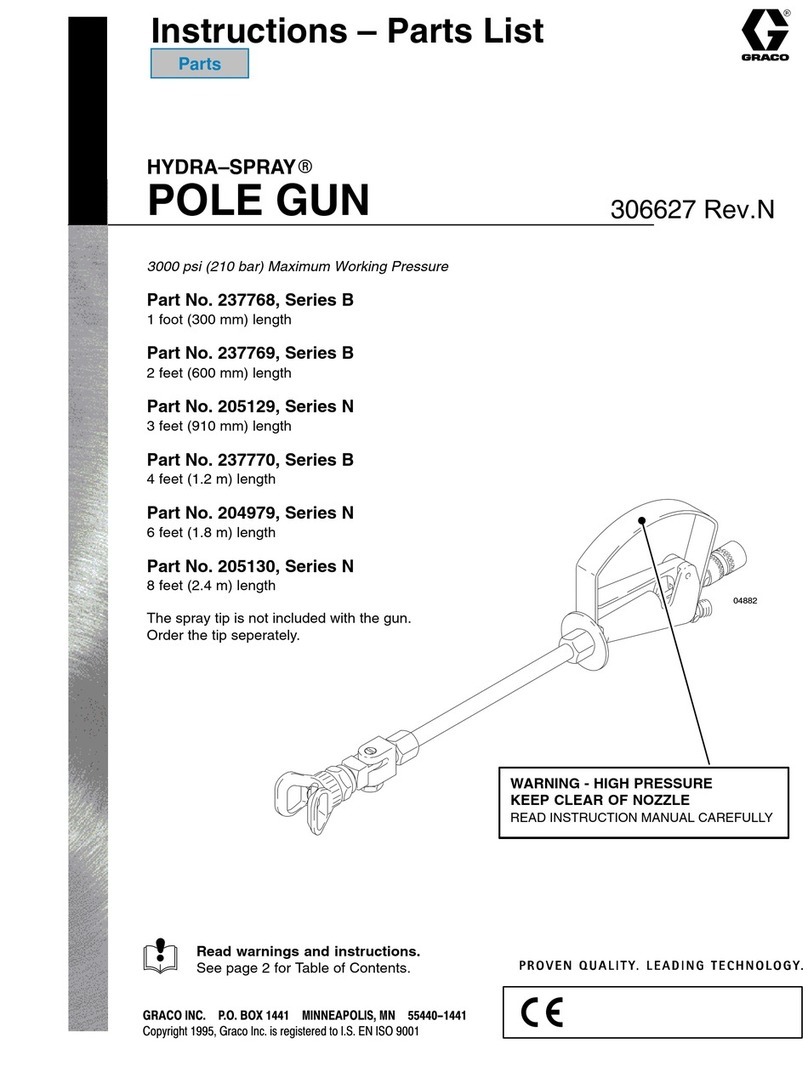Cualquier mal
us0
del equipo pulverizador
o
10s
acCesorioS, tal
Seguridad general
como sobre presurizacih,
modification
de
piezas, us0 de
mat~rialesyproductosquimicosincompatibles,outilizaci6nde
pie& datiadas
o
desgastadas, puede hacen que se rompan y
causenlainyecci6ndefluidouotrasiesionescorporalesgraves,
incendio, explosi6n
o
dation
a
la propiedad.
Nunca alterar
o
modificar ningicna pieza de este equipo: el
hacerlo podria causar una averia.
Presi6n del sistema
fresi6n
De Trabajo Mdxima. Asegurar que todo el equipo pul-
estb pulverizadora puede desarrollar 195 barias
(2750
psi) De
verizadorysusaccesoriostienenlacapacidadparaaguantarla
presi6n maxima de trabajo de est& pulverizadora NO exceder
cesorio de este sistema.
la presi6n mAxima de trabajo de ningtjn componente
o
ac-
Compatibilidad de fluido
Siempreleerlasinstrucci6nesdelfabricantedelfluidoysolvente
antes de usarlos en est6 pulverizadora, dadas en la pagina
36.
Revisar con regularidad el equipo pulverizador y reparar
o
respiradero, tal
como
recomiendan ios fabricantes del fluido y
Siempre usar galas, guantes, vestimetas protectora y un~
reemplazar de inmediato las piezas datiadas
0
desgastadas. del solvente.
.~
-
SEGURIDAD
EM
EL US0 DE
US
MAMGUERAS
-
Elfluidoqueescapaaaltapresi6nporlasmangueraspuedeser
Manejarypasarcuidadosamentelasmangueras.Notirarde1as
muy
peligroso. Si en la manguerase desarrolla un escape, una mangueras para mover el equipo. No usar fluidos
o
solventes
rotura
o
rajadura debldo a cualquier tip0 de desgaste, datio
o
que Sean incompatibles con el tub0 interno y la cubierta dela
maltrato. el chorro a alta presibn emitido por alii puede causar manguera. No exponer
las
mangueras a temperaturas sobre
una lesion por inyeccion
u
otras lesiones corporales graves
o
82-
c
(1800
R
0
baio -400
c
(-40"
R.
datios a la propiedad.
ITodaslasmanguerasparafluldostlenenquetenerguardas
de resorte en ambos extremosl Estas protegen
las
man-
manguera
guerascontradoblecesore~orce~urasenlosacop~amiento~o
Lacontinuidaddelcircuitodepuestaatierraapropiadoesesen-
cercade
ellos,
los
quepodrian
traducirse
en
rOturaS
de
la
man-
cialparamantenerconectadoatierraelsistemapulverizador.Es
"llP?P
indispensable revisar la resistencia electrica mAxima de las
.
Continuidad del circuit0 de puesth a tierra de la
yv","
fluido a alta presi6n puede desalojar un acoplamiento suelto
o
Antes de usarlas, Apretar bien firmes todas las conexiones. El
dejar que por
el
escape un chorro a alta presion.
Nuncausarunamangueraqueestadatiada.Siempre,revisarla
en buscade cortaduras, escapes, abrasion, cubierlaabultada,
o
acoplamientos sueltos
o
dahados. Si llegara a encontrarse
cualquiera de estbs condiciones, reemplazar de inmediato la
manguerasdeaireydefluidoporlomenosunavezalasemana.
Si la manguera no tiene una etiqueta en la cual se especifica la
fabricantedelamangueraparalainformacibnsobreloslimites
resistencia electrica, ponerse en contact0 con el proveedor
o
de resistencia. Usar un metro de resistencia en la gama
apropiade para comprobar la resistencia; si excede
10s
limites
recomendados,
reemplazarladeinmediato.
Esmuyarriesgado
tener una manouera sin Duesth a tierra
o
con
la ouesta a tierra
manguera. NOintentarracoplar
unamangueradealtapresibn
en malas conkcidnes. 'Leer tambien la informacibn~sobre
o
enmendarla con cinta adhesiva u OtrO material similar. Una RIESGO
DE
INCENDIO
0
EXPLOSION.
mas
arriba.
manguera que ha sido remendada no aguante el fluido a alta
presi6n.
-
PELIGRO DE INCENDIQ
0
EXPLOSION
-
.,
El flujo a aka velocidad del fluido al pasar por la bomba y man-
guera crea electricidad estatica. Si todas las partes del equipo
pulverizador no tienen buena tierra, pueden ocurrir chispas,
convirtiendo al sistema en algo peligroso. Tambien, pueden
producirse chispasaenchufar
o
desenchufarel cordon electri-
co. Est& chispaspueden
inflamarlosvaporesdelossolventes
yelchorrodefluidopulverizado,particulasdepolvoyotrassus-
tanciasinflamables,seaalairelibreobajotecho,loquepodria
causarunaexplosionoincendioygraveslesionescorporalesy
dafios al a propiedad. Enchufar siempre la pulverizadora a un
tomacorrientequeseencuentreaporlomenos6m(ZOpies)de
la maquina y del area que se va a rociar.
choqueelectricomientrasseusaelequipo,de)ardepulverlzar
Si ocurre una chispade electricidad estatica
o
incluso un ligero
de Inmediato. Revisar todo el sistema en busca de una tierra
y solucihado el problema.
apropiada.Nousardenuevoe1sistemahastahaberidentificado
Peusta a tierra
Para reducir
el
reisgo de chispas estaticas, conectar a tierra
la
pulverisadora y todo el otro equipo de pulverisar que se use
0
se encuentre en el lugar que se va a rociar. Consultar el codigo
electric0 delalocaiidad para las
instruccionessobrelasconex-
de conectar a tierra todo este equipo pulverisador:
iones a tierra exigidas para la zona
y
tip0 de equipo. Asegurar
1.
Pufverizadora: enchufar el cordbn electrico,
o
cable exten-
sor, cada uno un enchuf de trhs patas en buen estado, a
un tomacorreinte con puesat a tierra aporpiado. No usar un
trhs hilos y una capacidad de 15 amperios.
adaptador. Totos
10s
cables extensores tienen que tener
2.
Mangueras para fluidos: usar solamente mangueras con
puesta a tierra de una longitud combinada de 150
m
(500
pies), para asequrar buena continuidad a tierra. Referirse
tambien al parrafo sobre continuidad a tierra de la
manugeura.
3.
Pistola: hace la puesth a tierra conectandola a una man-
guera de fluido y pulverizadora bien conectadas a tierra.
4.
Suministrar
un
fecipiente: de acuerdo al codigo de la
localidad.
5.
Objeto que se estd rociando: de conformidad con el
codigo local.
6.
Todos
/os
baldes de solvente usados durante el lavado. de
de metal, que Sean conductivos. no colocar el balde en
conformidad
con
el codigo local. Usar solamente baldes
interumpe la continuidad a tierra.
una superficie no conductiva,
como
papel
o
canon, que
7.
Para mantenar la continuidad a tierra durante el lavado
o
descarga de
presion,
siempre apoyar una parte metaiica
de la pistola bien firme contra el costado del balde
de
metal, despues apretar el gatillo.
Seguridad durante el lavado
Para reducir el riesgo de que se inyecte
o
salpique fluido en la
siempre seguir las Instrucciones Para
El
Lavado. dadas en la
piel,
o
que ocurra una descarga de electricidad estatica,
pbgina.14 Seguir el procedlmlento de descarga de presibn
en la pigna
6,
y quita la boquilla rociadora antes de lava,:
Apoyarunapartemetalicadelapistolabienfirmecontraelcos-
tadodeunbaldedemetalyusarlepresi6nmasbajaposiblede
fluido durante el lavado.
308-216
7
